Measuring philanthropy's impact on racial equity
How to capture racial equity efforts at the individual, organizational, and community level through the True Impact social impact reporting tool
Recent racial justice movements have brought equity to the center of corporate and foundation grant making and reporting. Diversity, equity, inclusion, and accessibility goals have moved from isolated human resource efforts and Employee Resource Groups to broader employee engagement and community giving initiatives. In order to establish and track progress towards newly created racial equity goals, donors must establish reporting protocols to capture these outcomes.
The True Impact reporting platform has several mechanisms to capture how individuals, organizations, and communities of color are affected by social impact programs.
Below we have outlined how each section of our reports highlight how a program frames its racial equity goals, where and who it serves, and the resulting positive outcomes from implementation. You may harvest these data from your own social impact reports to share with stakeholders, as appropriate.
Note: as illustrations, we have included images from a sample report of a program that trains teachers to be attentive to racial equity in their curriculum and classrooms, leading to more inclusive school environments and positive youth development outcomes.
What: Program Overview and Intervention
The Intervention section describes the program being implemented, including strategies and tactics to improve racial equity in the stated community. This section answers the question "What approaches does the program take to build greater inclusion and belonging?"
Example program overview and intervention sections
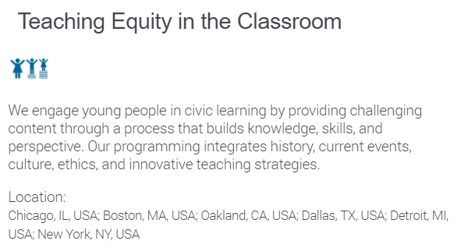
Who: Beneficiaries
Identifying who benefits from a program is critical to reporting on impacts of diversity and inclusion programs or other kinds of programs seeking to apply an equity lens to their work. In True Impact reports, demographic categories and percentages are reported at the program participant level, including race, age, disability, sex, pregnancy, religion, and sexual orientation. This can be used with program participation and outcome data to understand who benefits from a program.
Example demographic selection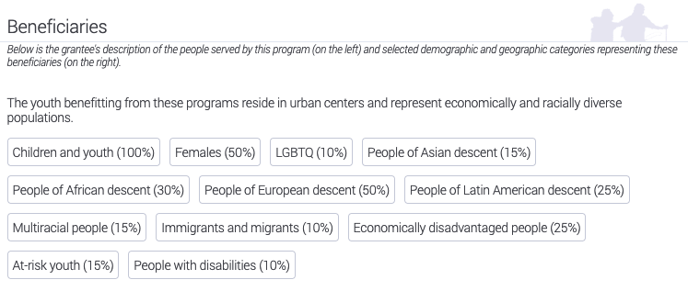
Where: Location
Forces that create racial inequality and perpetuate historical racial disparities -- e.g., residential redlining, white flight, and divestment in public schools and infrastructure -- often occur at the community level. Understanding where programs are implemented is important to frame how a program can improve access to resources in a community with higher barriers to success. A program serving residents of a historically unreserved community may classify their positive outcomes as advancing equity, irrespective of the type of outcome achieved. True Impact reports collect location data and maps program reach by location in order to contextualize the geographic dimension of investments.
How: Logic Model
True Impact uses a logic model to capture indicators along the life cycle of a program including the following five stages: (1) Program Development, (2) Reach, (3) Learn, (4) Act, and (5) Social Impact.
For programs focused on promoting diversity and inclusion generally, typical indicators include leadership development, increased civic engagement, and expanded inclusion and social safety. Alternatively, diversity and inclusion efforts may target specific social issue areas, such as employment, health, education, and youth development programs. In these cases, appropriate tracking includes a combination of what is being achieved (e.g., improve employment, health, or education) and by whom (target demographics, such as race, age, or identity).
Listed below are some key indicators that we recommend using when measuring racial equity work in your programming and True Impact report, outlined by our five logic model stages:
Program Development
- Forecast and report on the institutional policies and laws changed that affect racial and ethnic communities and individuals. Then, report on the outcome of these changes in the social impact (Succeed) section, using indicators like people gain improved community resources, or indicators of improved social, economic, and environmental wellbeing.
- Track the level of engagement with community leaders and stakeholders who are most affected by programs, particularly those who are disadvantaged or marginalized. This can improve program implementation and participation, leading to a more inclusive program reach (Reach indicator: people reached) or program outcomes (Succeed indicators: improve economic, social, or environmental wellbeing).
- Use this indicator to report on program implementers trained and hired. For example, track the number of practitioners, teachers, and volunteers who are trained to counter implicit bias, or foster inclusive programming and communities. For youth programs, the result of successful teacher anti-bias training are positive student outcomes, collected in the Reach, Learn, Act, and Succeed stages of the logic model. Students may gain safe and affirming classrooms, improve their emotional wellbeing, or improve their attendance and academic performance.
Example Program Development indicators
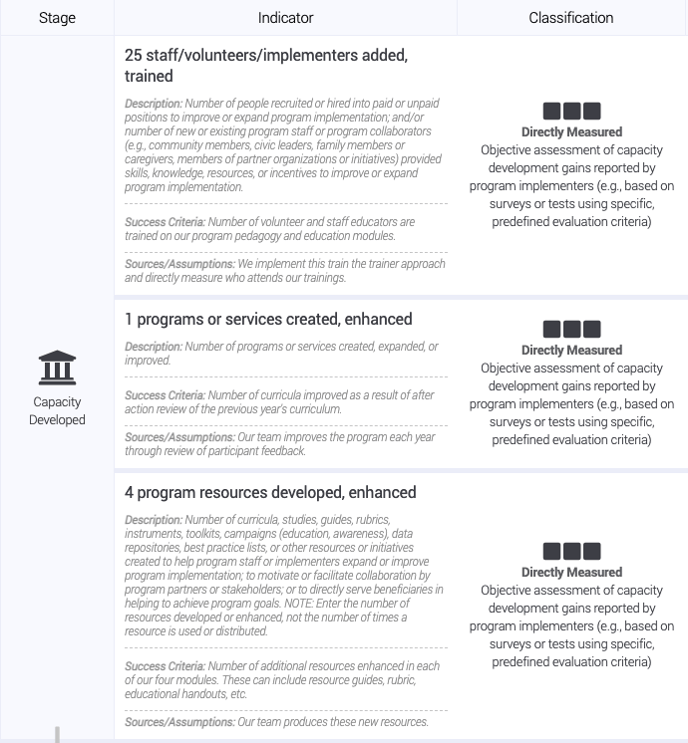
Reach: Program participation
- The number of people who participate is a key indicator for expanding and ensuring access to a program for underrepresented communities. This indicator is required for all nonprofits to report in the True Impact system.
Example Reach indicator

Learn: Expanding awareness and skills
- Forecast and report the number of people who increase skills, learning, motivation, and access to resources through the program. For diversity and inclusion programs, the indicator may be related to improved awareness and skills to identify and address racial bias. For programs expanding access and success, who learns and where learning occurs can be used to apply an equity lens to this indicator.
Example Learn indicator
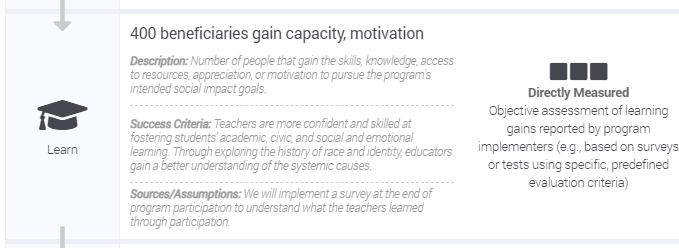
Act: Taking action to expand equity
- For some programs, behavior change enables participants to achieve end outcomes by taking some form of action. Use this indicator to track how, as a result of increased access, participants are able to improve their school attendance and engagement, or to apply for jobs or social services.
Example Act indicator

Succeed: Program outcomes
True Impact's success indicators provide structure to report on how funded program move people and communities toward equitable opportunities and outcomes for all. Sometimes, programs are designed to directly repair harm, racial segregation, and racial injustice. Others do so by expanding program locations or availability -- and the resulting successful outcomes -- to underserved communities. Below are examples of how to capture positive outcomes for program beneficiaries in your True Impact report.
Inclusive schools and positive youth development
- Academic disparities: improve academic performance; graduate on time; access post-secondary education; earn post-secondary degree, credential
- Unequal representation and engagement: strengthen civic engagement; community leaders activated, strengthened
- Safe and inclusive schools: gain safe and affirming environments; improve social and emotional wellbeing; protect, improve health
- Economic inequalities: attain, retain, or improve employment; socio-economic savings; improved community resources
Example Success indicators
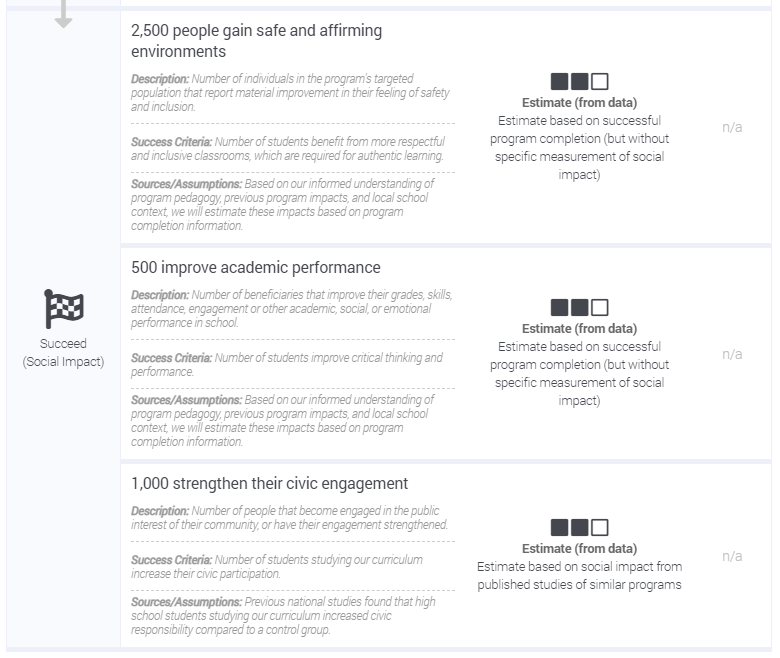
- Income Inequality: Employment, job quality and income, reduced debt and improved savings
- Educational and Training Achievement Gap: Improve attendance, graduation, and degree/certificates
- Reduced Quality of Care: improve health outcomes
- Exposure to Environmental Contaminants: improve health outcomes
- Distrust and Historical Trauma: avoid violence, improved trust, safety
- Mental Health: improve mental health
- Access to Housing: attain and retain sustainable, affordable housing
- Hate Crimes and Hate Speech: avoid violence, improved trust, safety
- Voting Rights and Representation: voting, civic leadership
- Incarceration and Criminalization: avoid incarceration, reduce recidivism
- Police Violence: avoid violence, improved trust in the police, improved safety
Narratives
In True Impact's reporting system, programs that are sharing their final outcomes have two opportunities to provide narrative information about their achieved outcomes: